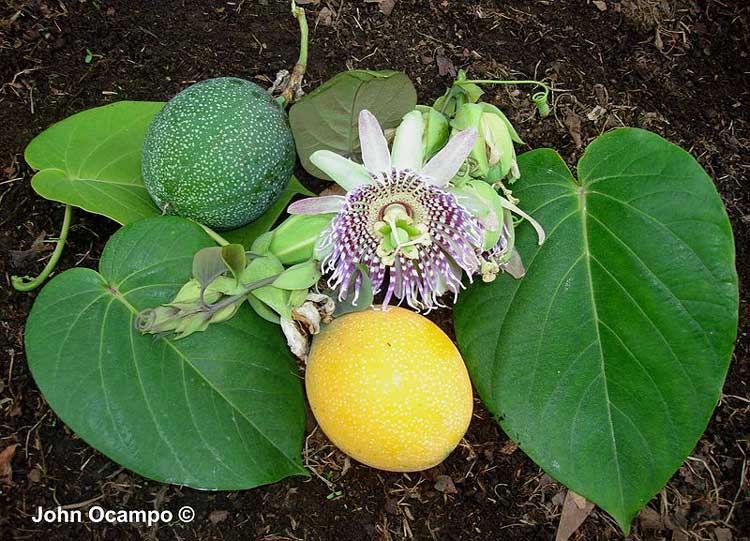
Passiflora ligularis (*)
Classification System: APG IV
Superregnum: Eukaryota
Regnum: Plantae
Cladus: Angiosperms
Cladus: Eudicots
Cladus: Core eudicots
Cladus: Rosids
Cladus: Eurosids I
Ordo: Malpighiales
Familia: Passifloraceae
Genus: Passiflora
Subgenus: P. subg. Passiflora
Supersectio: P. supersect. Laurifolia
Series: P. ser. Tiliifoliae
Species: Passiflora ligularis
Name
Passiflora ligularis Juss., Ann. Mus. Nat. Paris vol. 6, 113. 1805.
Synonyms
Passiflora ligularis f. lobata (Mast.) Killip, Publ. Field Mus. Nat. Hist., Bot. Ser. 1938.
Passiflora ligularis var. geminiflora DC., Prodr. 3: 328 1828.
Passiflora ligularis var. lobata Mast., Bot. Jahrb. Syst. 8: 219 1887.
Passiflora serratistipula Moc. & Sessé ex DC., Prodr. 3: 328. 1828.
Passiflora tiliaefolia Sessé & Moc., Pl. Nov. Hisp., 154. 1887., nom. illeg. non L. (1753)
Passiflora lowei Heer ex Regel, Gartenfl. vol. 1, 69, t. 9. 1852.
References
Tropicos.org. Missouri Botanical Garden. 16 Feb 2009 [1].
USDA, ARS, Germplasm Resources Information Network. Passiflora ligularis in the Germplasm Resources Information Network (GRIN), U.S. Department of Agriculture Agricultural Research Service. Accessed: 09-Oct-10.
Vernacular names
suomi: Makeapassio
magyar: Édes granadilla
svenska: Sötgrenadill
Passiflora ligularis, commonly known as the sweet granadilla or grenadia, is a plant species in the genus Passiflora.[1][2] It is known as granadilla in Bolivia, Colombia, Nicaragua, Costa Rica, Ecuador, Mexico, The Azores, South Africa and Peru; granadilla común in Guatemala; granadilla de China or parcha dulce in Venezuela and granaditta in Jamaica.[3]
Description
The epithet ligularis comes from the plant's ligulate corollae. It is native to the Andes Mountains, mainly Peru, including Bolivia, Costa Rica, Ecuador, Colombia and Venezuela. It grows as far south as northern Argentina and as far north as Mexico. Outside of its native range it grows in the tropical mountains of Africa and Australia (where they are known as passionfruit or Granadilla), and is now common in local markets of Papua New Guinea, where it is known as 'sugar fruit'. It likes climates ranging from 15 to 18 °C (59 to 64 °F) and between 600 and 1,000 millimetres (24 and 39 in) of annual rain. It lives at altitudes ranging from 1,700 to 2,600 metres (5,600 to 8,500 ft) above sea level. They have abundant, simple leaves and greenish-white flowers. The fruit is orange to yellow colored with small light markings. It has a round shape with a tip ending in the stem. The fruit is between 6.5 and 8 centimetres (2+1⁄2 and 3+1⁄4 in) long and between 5.1 and 7 centimetres (2 and 2+3⁄4 in) in diameter. The outer shell is hard and slippery, and has soft padding on the interior to protect the seeds. The seeds, which are hard and black, are surrounded by a gelatinous sphere of transparent pulp. The pulp is the edible part of the fruit and has a soft sweet taste. It is very aromatic and contains vitamins A, C, and K, phosphorus, iron, and calcium. The main producers are Peru, Venezuela, Colombia, Ecuador, Brazil (where it is known as maracujá doce or "sweet passion fruit"), South Africa, Rwanda and Kenya. The main importers are the United States, Canada, Belgium, the Netherlands, Switzerland, and Spain.
Passiflora ligularis, is an evergreen climbing shrub, producing stems of up to 5 metres (16 ft) long. The stems scramble over the ground or clamber into the surrounding vegetation, attaching themselves by means of coiling tendrils.[4]
References
"Passiflora ligularis (sweet granadilla)". cabi.org. CABI.
"Sweet Granadilla - Passiflora ligularis - Seeds". tradewindsfruit.com.
"Sweet Granadilla". hort.purdue.edu.
Vanderplank, John (1991). Passion flowers and passion fruit. London: Cassell. ISBN 0-304-34076-6.
External links
Retrieved from "http://en.wikipedia.org/"
All text is available under the terms of the GNU Free Documentation License

